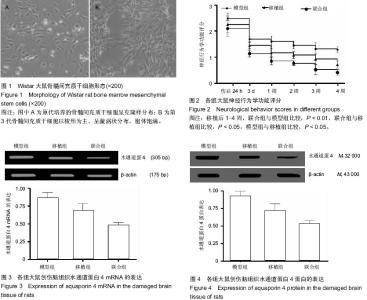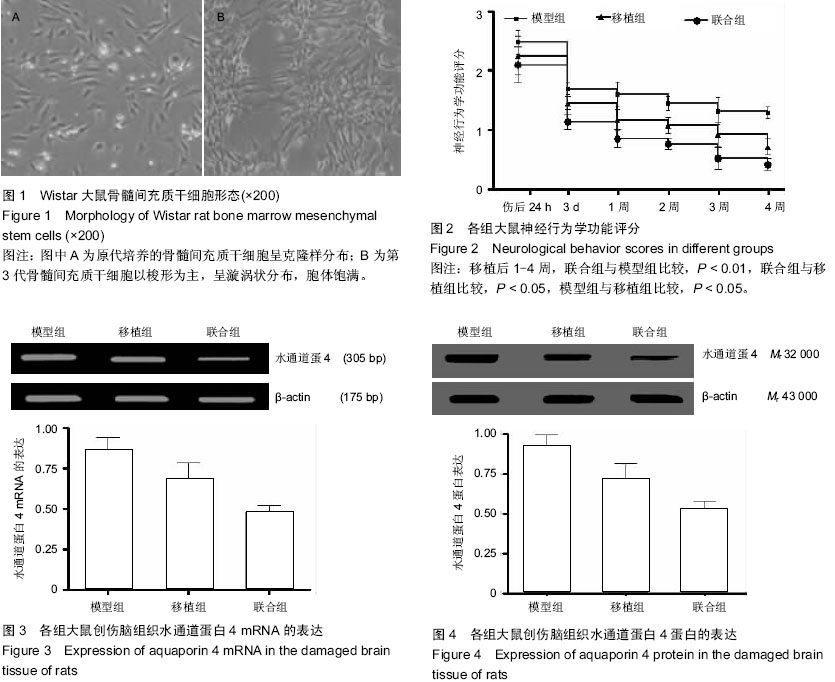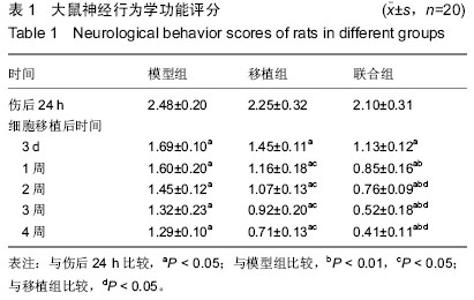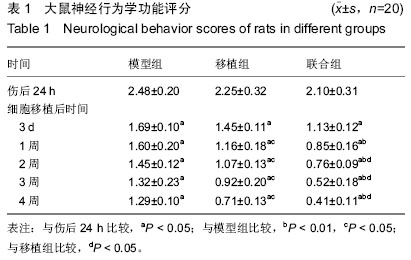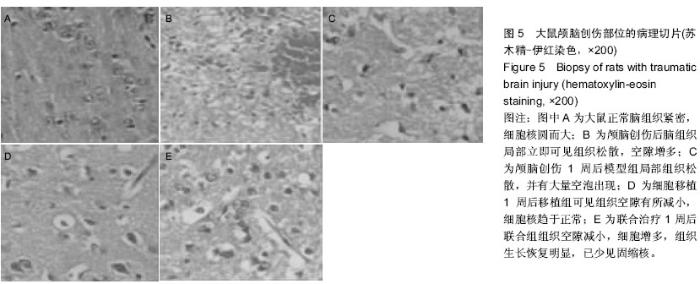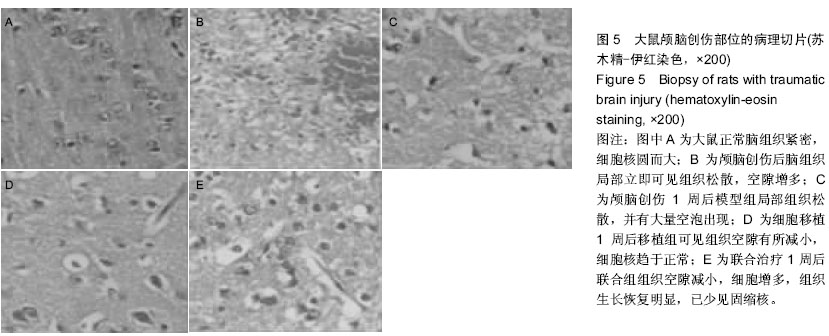Chinese Journal of Tissue Engineering Research ›› 2015, Vol. 19 ›› Issue (36): 5811-5815.doi: 10.3969/j.issn.2095-4344.2015.36.013
Previous Articles Next Articles
Ganglioside combined with bone marrow mesenchymal stem cells transplantation for treatment of traumatic brain injury
Huang Yong-hui
- Department of Neurosurgery, Xianshuigu Hospital of Jinnan District, Tianjin 300040, China
-
Online:2015-09-03Published:2015-09-03 -
About author:Huang Yong-hui, Attending physician, Department of Neurosurgery, Xianshuigu Hospital of Jinnan District, Tianjin 300040, China
CLC Number:
Cite this article
Huang Yong-hui. Ganglioside combined with bone marrow mesenchymal stem cells transplantation for treatment of traumatic brain injury [J]. Chinese Journal of Tissue Engineering Research, 2015, 19(36): 5811-5815.
share this article
| [1] Xu J, Liao W, Gu D, et al. Neural ganglioside GD2 identifies a subpopulation of mesenchymal stem cells in umbilical cord. Cell Physiol Biochem. 2009;23(4-6):415-424. [2] 武俏丽,李庆国,刘暌.干细胞移植治疗脊髓损伤研究进展[J].中国组织工程研究与临床康复,2008,12(12):2343-2346. [3] Drayna PC, Abramo TJ, Estrada C. Near-infrared spectroscopy in the critical setting. Pediatr Emerg Care. 2011;27(5):432-439. [4] She JQ, Wang M, Zhu DM, et al. Monosialoanglioside (GM1) prevents lead-induced neurotoxicity on long-term potentiation, SOD activity, MDA levels, and intracellular calcium levels of hippocampus in rats. Naunyn Schmiedebergs Arch Pharmacol. 2009;379(5):517-524. [5] 蒋红梅,龚燕梅.神经节苷脂对急性脑出血患者神经元特异性烯醇化酶的影响[J].医学综述,2011,17(14):2227-2228. [6] Lim ST, Esfahani K, Avdoshina V, et al. Exogenous gangliosides increase the release of brain-derived neurotrophic factor. Neuropharmacology. 2011;60(7-8): 1160-1167. [7] Cummings DM, Belluscio L. Continuous neural plasticity in the olfactory intrabulbar circuitry. J Neurosci. 2010;30(27): 9172-9180. [8] Liu YJ, Wang Q, Li B. Neuronal responses to looming objects in the superior colliculus of the cat. Brain Behav Evol. 2011; 77(3):193-205. [9] Galvin KA, Jones DG. Adult human neural stem cells for cell-replacement therapies in the central nervous system. Med J Aust. 2002;177(6):316-318. [10] Huang F, Dong X, Zhang L, et al. The neuroprotective effects of NGF combined with GM1 on injured spinal cord neurons in vitro. Brain Res Bull. 2009;79(1):85-88. [11] Hydén LC. The importance of providing scaffolding to support patient narratives when brain damage impairs storytelling ability. Top Stroke Rehabil. 2011;18(1):52-54. [12] Agrawal A, Garg LN. Split calvarial bone graft for the reconstruction of skull defects. J Surg Tech Case Rep. 2011; 3(1):13-16. [13] 穆晓红,赵子义,徐林,等.密度梯度离心法体外培养骨髓间充质干细胞的分化能力[J].中国组织工程研究与临床康复,2011, 15(27): 4955-4958. [14] Wang J, Zhang R, Shen Y, et al. Recent advances in cell sheet technology for periodontal regeneration. Curr Stem Cell Res Ther. 2014;9(3):162-173. [15] Lu Y, Hui G, Liu F, et al. Survival and regeneration of deep-freeze preserved autologous cranial bones after cranioplasty. Br J Neurosurg. 2012;26(2):216-221. [16] Linden MA, McClure J. The causal attributions of nursing students toward adolescent survivors of brain injury. Nurs Res. 2012;61(1):58-65. [17] Seyed Jafari SS, Ali Aghaei A, Asadi-Shekaari M, et al. Investigating the effects of adult neural stem cell transplantation by lumbar puncture in transient cerebral ischemia. Neurosci Lett. 2011;495(1):1-5. [18] Hassanein AH, Arany PR, Couto RA, et al. Cranial particulate bone graft ossifies calvarial defects by osteogenesis. Plast Reconstr Surg. 2012;129(5):796e-802e. [19] Thompson HJ, Weir S, Rivara FP, et al. Utilization and costs of health care after geriatric traumatic brain injury. J Neurotrauma. 2012;29(10):1864-1871. [20] Su J, Haner CV, Imbery TE, et al. Reelin is required for class-specific retinogeniculate targeting. J Neurosci. 2011; 31(2):575-586. [21] 刘爱民.临床各种体液标本中神经节苷脂变化意义的研究进展[J].中国现代医药杂志,2007,9(2):152-154. [22] Haider M, Cappello J, Ghandehari H, et al. In vitro chondrogenesis of mesenchymal stem cells in recombinant silk-elastinlike hydrogels. Pharm Res. 2008;25(3):692-699. [23] 张供,谷兴华,宋毅,等.单唾液酸神经节苷脂对大鼠缺血再灌注脑损伤的保护作用[J].山东大学学报:医学版,2006,44(3):252-255. [24] Polak SJ, Levengood SK, Wheeler MB, et al. Analysis of the roles of microporosity and BMP-2 on multiple measures of bone regeneration and healing in calcium phosphate scaffolds. Acta Biomater. 2011;7(4):1760-1771. [25] 张赛.颅脑创伤后神经行为障碍的认识和药物治疗[J].中华神经外科杂志,2007,23(7):481-482. [26] Becker C. Nursing care of the brain injury patient on a locked neurobehavioral unit. Rehabil Nurs. 2012;37(4):171-175. [27] 张荣洁.脑损伤高危儿早期干预与护理[J].护理实践与研究,2012, 9(1):56-57. [28] Li J, Li Y, Ma S, et al. Enhancement of bone formation by BMP-7 transduced MSCs on biomimetic nano-hydroxyapatite/ polyamide composite scaffolds in repair of mandibular defects. J Biomed Mater Res A. 2010;95(4):973-981. [29] Liu Y, Ming L, Luo H, et al. Integration of a calcined bovine bone and BMSC-sheet 3D scaffold and the promotion of bone regeneration in large defects. Biomaterials. 2013;34(38): 9998-10006. [30] 钟池,钟春玖,罗玉敏,等.骨髓基质细胞静脉移植治疗大鼠短暂性局灶性脑缺血[J].中华神经医学杂志,2004,3(2):89-92. [31] Kim S, Honmou O, Kato K, et al. Neural differentiation potential of peripheral blood- and bone-marrow-derived precursor cells. Brain Res. 2006;1123(1):27-33. |
| [1] | Jiang Tao, Ma Lei, Li Zhiqiang, Shou Xi, Duan Mingjun, Wu Shuo, Ma Chuang, Wei Qin. Platelet-derived growth factor BB induces bone marrow mesenchymal stem cells to differentiate into vascular endothelial cells [J]. Chinese Journal of Tissue Engineering Research, 2021, 25(25): 3937-3942. |
| [2] | Chen Yang, Huang Denggao, Gao Yuanhui, Wang Shunlan, Cao Hui, Zheng Linlin, He Haowei, Luo Siqin, Xiao Jingchuan, Zhang Yingai, Zhang Shufang. Low-intensity pulsed ultrasound promotes the proliferation and adhesion of human adipose-derived mesenchymal stem cells [J]. Chinese Journal of Tissue Engineering Research, 2021, 25(25): 3949-3955. |
| [3] | Zhang Lishu, Liu Anqi, He Xiaoning, Jin Yan, Li Bei, Jin Fang. Alpl gene affects the therapeutic effect of bone marrow mesenchymal stem cells on ulcerative colitis [J]. Chinese Journal of Tissue Engineering Research, 2021, 25(25): 3970-3975. |
| [4] | Ruan Guangping, Yao Xiang, Liu-Gao Miyang, Cai Xuemin, Li Zian, Pang Rongqing, Wang Jinxiang, Pan Xinghua. Umbilical cord mesenchymal stem cell transplantation for traumatic systemic inflammatory response syndrome in tree shrews [J]. Chinese Journal of Tissue Engineering Research, 2021, 25(25): 3994-4000. |
| [5] | Mo Jianling, He Shaoru, Feng Bowen, Jian Minqiao, Zhang Xiaohui, Liu Caisheng, Liang Yijing, Liu Yumei, Chen Liang, Zhou Haiyu, Liu Yanhui. Forming prevascularized cell sheets and the expression of angiogenesis-related factors [J]. Chinese Journal of Tissue Engineering Research, 2021, 25(22): 3479-3486. |
| [6] | Chen Lei, Zheng Rui, Jie Yongsheng, Qi Hui, Sun Lei, Shu Xiong. In vitro evaluation of adipose-derived stromal vascular fraction combined with osteochondral integrated scaffold [J]. Chinese Journal of Tissue Engineering Research, 2021, 25(22): 3487-3492. |
| [7] | Wei Qin, Zhang Xue, Ma Lei, Li Zhiqiang, Shou Xi, Duan Mingjun, Wu Shuo, Jia Qiyu, Ma Chuang. Platelet-derived growth factor-BB induces the differentiation of rat bone marrow mesenchymal stem cells into osteoblasts [J]. Chinese Journal of Tissue Engineering Research, 2021, 25(19): 2953-2957. |
| [8] | Chen Xiao, Guo Zhi, Chen Lina, Liu Xuanyong, Zhang Yihuizhi, Li Xumian, Wang Yueqiao, Wei Liya, Xie Jing, Lin Li. Factors affecting the mobilization and collection of autologous peripheral blood hematopoietic stem cells [J]. Chinese Journal of Tissue Engineering Research, 2021, 25(19): 2958-2962. |
| [9] | Guo Zhibin, Wu Chunfang, Liu Zihong, Zhang Yuying, Chi Bojing, Wang Bao, Ma Chao, Zhang Guobin, Tian Faming. Simvastatin stimulates osteogenic differentiation of bone marrow mesenchymal stem cells [J]. Chinese Journal of Tissue Engineering Research, 2021, 25(19): 2963-2968. |
| [10] | Li Congcong, Yao Nan, Huang Dane, Song Min, Peng Sha, Li Anan, Lu Chao, Liu Wengang. Identification and chondrogenic differentiation of human infrapatellar fat pad derived stem cells [J]. Chinese Journal of Tissue Engineering Research, 2021, 25(19): 2976-2981. |
| [11] | Gao Yuanhui, Xiang Yang, Cao Hui, Wang Shunlan, Zheng Linlin, He Haowei, Zhang Yingai, Zhang Shufang, Huang Denggao. Comparison of biological characteristics of adipose derived mesenchymal stem cells in Wuzhishan inbreed miniature pigs aged two different months [J]. Chinese Journal of Tissue Engineering Research, 2021, 25(19): 2988-2993. |
| [12] | Cao Yang, Zhang Junping, Peng Li, Ding Yi, Li Guanghui. Isolation and culture of rabbit aortic endothelial cells and biological characteristics [J]. Chinese Journal of Tissue Engineering Research, 2021, 25(19): 3000-3003. |
| [13] | Dai Min, Wang Shuai, Zhang Nini, Huang Guilin, Yu Limei, Hu Xiaohua, Yi Jie, Yao Li, Zhang Ligang. Biological characteristics of hypoxic preconditioned human amniotic mesenchymal stem cells [J]. Chinese Journal of Tissue Engineering Research, 2021, 25(19): 3004-3008. |
| [14] | Qin Yanchun, Rong Zhen, Jiang Ruiyuan, Fu Bin, Hong Xiaohua, Mo Chunmei. Chinese medicine compound preparation inhibits proliferation of CD133+ liver cancer stem cells and the expression of stemness transcription factors [J]. Chinese Journal of Tissue Engineering Research, 2021, 25(19): 3016-3023. |
| [15] | Dai Yaling, Chen Lewen, He Xiaojun, Lin Huawei, Jia Weiwei, Chen Lidian, Tao Jing, Liu Weilin. Construction of miR-146b overexpression lentiviral vector and the effect on the proliferation of hippocampal neural stem cells [J]. Chinese Journal of Tissue Engineering Research, 2021, 25(19): 3024-3030. |
| Viewed | ||||||
|
Full text |
|
|||||
|
Abstract |
|
|||||
